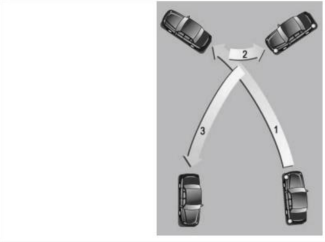Turnabouts
Turnabouts are maneuvers in which you may turn your car around to drive in the opposite direction.
You may be asked to perform a turnabout during your driving skills test. To plan your turnabout, you should make certain of the following:
- There are no signs which prohibit a turnabout, such as a “No “U” Turn” sign(s).
- You cannot cross a solid yellow line at any time.
- Local statutes may prohibit turnabouts; you should be familiar with local traffic regulations.
- You have clear visibility in each direction for a distance of five hundred (500) feet.
- There are no hills or curves nearby which could obstruct your view of on-coming traffic.
- You are at least two hundred (200) feet from an intersection.
- You have enough space to complete the maneuver.
- You are not in an area of heavy traffic.
- There are no pedestrians in your path.
You must then decide which turnabout you will use. There are four (4) types. You must choose the safest and best suited for traffic conditions and the street on which you will make your turnabout.
“U” turn:
- You must have sufficient space to complete this maneuver.
- Check for traffic in both directions.
- Signal that you will be pulling to the right curb and stop.
- Signal your intent with your left turn signal or turn on your four-way hazard lights.
- Check traffic in both directions.
- When you have a clear path, turn the steering wheel all the way to the left and slowly drive to the left, completing the maneuver.
- Make sure to cancel your directional signal or turn off the hazard lights upon completing your “U” turn.
- In Rhode Island, you may make a “U” turn only when it is allowed and does not interfere with the free flow of traffic in either direction.
Backing into a driveway or side-street on the right side:
- This turnabout allows you to reenter traffic by driving forward,
- Signal your intent to pull to the right side of the street,
- Drive past the street or driveway you plan to back into,
- Check for pedestrians and traffic in both direction and when clear,
- Begin to back up, slowly turning the steering wheel to the right.
- When you have completed your backing maneuver, straighten the steering wheel, and stop once you have cleared the curb line,
- After you have stopped on the side street or driveway, check for oncoming traffic, signal your intention to turn and if clear proceed by entering the main street again.
Pulling into a street or driveway on the left:
- This maneuver is more hazardous because you will be backing into the travel lane.
- Choose a street or driveway on the left which has clear visibility in both directions, when you have entered the street or driveway (the car has crossed the curb line), straighten the front wheels and stop,
- Look in both directions for pedestrian and vehicular traffic,
- Turn the steering wheel to the right and slowly backup into the first lane of travel,
- At about the half-way point in the turn, begin to straighten the steering wheel,
- After completing the turn, stop, check for on-coming traffic and when the path is clear, signal and enter the flow of traffic.
The three-point turn:
Unless prohibited, you may use the three-point turn to turn around on a narrow street,
- Select a safe location to make this maneuver,
- Signal your intent to pull to the right side of the street,
- After you have come to a complete stop, signal your intent with your left directional signal or with the four-way hazard lights,
- Check for on-coming traffic in both directions,
- Turn the steering wheel fully to the left and slowly drive forward, crossing the street,
- At a point before the left side curb, stop,
- Again, check for traffic in all directions,
- Turn the steering wheel fully to the right and begin to back up,
- When you have reached a point where the front of the car is in the middle of the street, stop,
- Again, check for traffic in all directions,
- Turn the steering wheel to the left and proceed in the opposite direction,
- Remember to turn off your directional signal or hazard lights.
